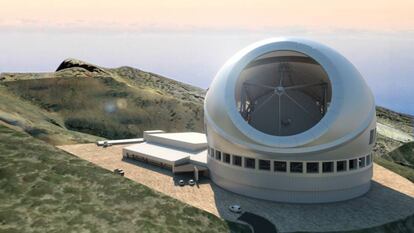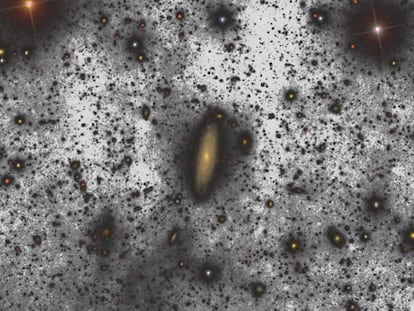Could the Thirty Meter Telescope be built in Spain’s Canary Islands?
The scientific consortium behind the observatory now has all the permits it needs to start work on the €1.2 billion-project in La Palma, if it cannot go ahead with the plan in Hawaii
The city hall of Puntagorda, a small municipality on La Palma in Spain’s Canary Islands, opened the door on Tuesday to the construction of the Thirty Meter Telescope (TMT). All the paperwork to build the pioneering 18-story tall €1.2 billion-scientific installation in Puntagorda is now in order. It is just up to the consortium behind the project to decide whether it will push ahead with its original plans to build the TMT in Hawaii, or switch to Plan B: the Canary Islands. If approved, work on the project will begin in La Palma next year in spring.
Mauna Kea continues to be the preferred site for the TMT
TMT consortium sources
The consortium wants to build the TMT on the summit of Mauna Kea in Hawaii, but Native Hawaiians have been blocking the construction of the telescope because they believe the site is sacred.
“We are excited and grateful to have been granted the building license in La Palma,” said sources from the consortium. “Mauna Kea continues to be the preferred site for the TMT, but this is a key step in the process to develop the Plan B site in La Palma, if it is not possible to build in Hawaii.”
The TMT partners have called a meeting for November 23, and having approval to build in Puntagorda, could help the group decide what to do. But sources from the consortium explained that “currently, there is no set date to determine our next steps for the building of the TMT.” They added: “The TMT board of directors regularly meets. This is a scheduled meeting to follow the evolution of the project both in Hawaii and in La Palma, as well as other issues.”
The consortium, which is made up of universities in the United States (California Institute of Technology and the University of California), Japan, India, Canada and China, requested the building license from Puntagorda city hall a few weeks ago. Under the license, 10 hectares of land will be ceded to the Canary Astrophysics Institute (IAC).
It is expected to take 10 years to build the telescope and its supporting installations. The project is likely to generate many jobs – and not only in the construction. Numerous technical position will be needed to oversee the scientific project, and more work could come from the development of equipment for the TMT.
Spanish scientists would also receive 10% of the TMT’s observing time to carry out their own projects
The TMT group also hopes to be a “good neighbor” to La Palma, after facing opposition from Hawaii, and is expected to make significant investment in training and education.
More than a dozen telescopes are already functioning on the peaks of La Palma, some of which are run by scientists and engineers from the area. The TMT project could multiply the work opportunities for these locals. Spanish scientists would also receive 10% of the TMT’s observing time to carry out their own astronomy projects.
The TMT began facing problems in 2014, when work began on the project in Mauna Kea, the highest summit in Hawaii, which the native people consider sacred. Although there are a dozen observatories already located on the summit, the Native Hawaiians had had enough. They blocked the roads and the building work was brought to a stop. A long legal battle ensued, which ended in July after a court gave the project the green light. But protesters began blocking the roads again. Four months later, the work is still at a standstill, and the project is beginning to fall out of favor with the public. Indeed, many high-profile scientists from the United States have asked for the telescope to be built in the Canary Islands.
Spanish authorities at all levels, from Congress to the regional government of the Canary Islands, have shown public support for the construction of the TMT. What’s more, the scientific leaders behind the TMT project have discovered that La Palma has excellent conditions for observing space. Although they are not as good as in Mauna Kea (which is 4,200 kilometers above sea level – nearly 2,000 kilometers higher than La Palma), the operating costs in the Canary Islands would be half the $40 million (€37 million) needed for the site in Hawaii – an important saving for an instrument that is expected to last 50 years. The project, however, has received criticism from the Spanish environmental group Ben Magec, which says the TMT will harm the local environment, and has promised in the media to oppose the plans.
English version by Melissa Kitson.
Tu suscripción se está usando en otro dispositivo
¿Quieres añadir otro usuario a tu suscripción?
Si continúas leyendo en este dispositivo, no se podrá leer en el otro.
FlechaTu suscripción se está usando en otro dispositivo y solo puedes acceder a EL PAÍS desde un dispositivo a la vez.
Si quieres compartir tu cuenta, cambia tu suscripción a la modalidad Premium, así podrás añadir otro usuario. Cada uno accederá con su propia cuenta de email, lo que os permitirá personalizar vuestra experiencia en EL PAÍS.
¿Tienes una suscripción de empresa? Accede aquí para contratar más cuentas.
En el caso de no saber quién está usando tu cuenta, te recomendamos cambiar tu contraseña aquí.
Si decides continuar compartiendo tu cuenta, este mensaje se mostrará en tu dispositivo y en el de la otra persona que está usando tu cuenta de forma indefinida, afectando a tu experiencia de lectura. Puedes consultar aquí los términos y condiciones de la suscripción digital.
More information
Archived In
Últimas noticias
The complicated life of Francesca Albanese: A rising figure in Italy but barred from every bank by Trump’s sanctions
Pinochet’s victims grapple with José Antonio Kast’s rise in Chile
Reinhard Genzel, Nobel laureate in physics: ‘One-minute videos will never give you the truth’
Half of Scotland is in the hands of 420 property owners
Most viewed
- Pablo Escobar’s hippos: A serious environmental problem, 40 years on
- Reinhard Genzel, Nobel laureate in physics: ‘One-minute videos will never give you the truth’
- Why we lost the habit of sleeping in two segments and how that changed our sense of time
- Charles Dubouloz, mountaineering star, retires at 36 with a farewell tour inspired by Walter Bonatti
- The Florida Keys tourist paradise is besieged by immigration agents: ‘We’ve never seen anything like this’












































